Locomotives of New Zealand
Locomotives of New Zealand is a complete list of all locomotive classes that operate or have operated in New Zealand's railway network. It does not include locomotives used on bush tramways.
| Part of a series on |
| Rail transport in New Zealand |
|---|
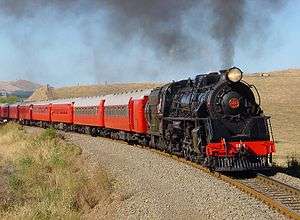 |
|
All New Zealand's main-line locomotives narrow gauge of 3ft 6in (1,067mm).
Classification details
Steam locomotives were originally categorised with just a single letter, such as the "F class". When a new class was built as an enhancement of an old class, the old class's letter was re-used, followed by a superscript upper-case letter. For example, the 1906 A class was followed by the AA and AB classes.
Diesel-electric and electric locomotive classifications originally consisted of an upper-case D or E respectively followed by a second and sometimes a third (sub-class) letter. The second and third letters are sometimes represented as smaller-sized upper case (for example, as seen on many locomotive cab-side number plates).[1]
New classes were not always given the classification that alphabetically followed that of the previous class that had most recently been acquired. For example, the DJ class was followed by the DX class followed by the DF class. If an entire class had been withdrawn from service and the classification no longer in use, it was sometimes re-used; for example, two A classes exist, one from 1873 and one from 1906.
Traffic Monitoring System
Following the introduction of the computer-based Traffic Monitoring System (TMS) and consequent renumbering, classes were identified by the two upper-case letters with the first letter remaining D or E respectively and sub-classes being indicated by a third upper-case letter, such as DAA (DA modified for hump shunting), DAR (DA with rebuilt superstructure), DFT (DF with turbo-conversion), DXR (rebuilt DX) and so on.[2] Most diesel-electric shunting locomotives have a three-letter classification with DS as the first two letters, following on from the original diesel-electric shunting class that was known simply as the DS class.
For electric locomotives the second letter generally referred to where the locomotive was based, such as EC in Christchurch, EO in Otira and EW in Wellington. The EM class in Wellington stands for Electric Motor and the ET stands for Electric Trailer. The DM class units were an exception to this.
Most railcars were classified RM (Rail Motor), and individual classes were known by alternate names such as the Vulcan railcars of the South Island and the Wairarapa railcars that ran over the Rimutaka Incline.
List of locomotive classes
Mainline diesel locomotives
| Image | Class | Numbers | Number in class | Year(s) introduced | Year(s) withdrawn | Power output | Notes | ||
|---|---|---|---|---|---|---|---|---|---|
| TMS (1979) | pre-1979 | TMS (1979) | pre-1979 | ||||||
 |
DA | DA | 86 - 996 | 1400 - 1545 | 146 | 1955 - 1967 | 1974 - 1989 | 1,060 kW (1,420 hp) | The largest locomotive number class in New Zealand, 85 were rebuilt as the DC class, five as DAA class[3] and one as DAR class. |
| DB | DB | 1001 - 1180 | 1000 - 1016 | 17 | 1965 - 1966 | 1980 - 1989 | 705 kW (945 hp) | Ten were rebuilt as the DBR class. | |
 |
DBR | 1199 - 1295 | 10 | 1980 - 1982 | 2002 – 2017 | 705 kW (945 hp) | Rebuilt DB with a new cab, lower hood and new engine. | ||
 |
DC | DC | 4006 - 4951 | 1551 - 1599 | 85 | 1978 - 1983 | 1992 – present | 1,100 kW (1,500 hp) 1,230 kW (1,650 hp) | Rebuilt DA with a new cab and low hood and appears in two engine types, one with 12-645C engines and the other with 12-645E engines. |
| DCP | 4277 - 4945 | 17 | 2002 - 2009 | 2015–present | 1,230 kW (1,650 hp) | DC subclass originally built for passenger services, but now used for other uses. | |||
 |
DF (1954) | 1500 - 1510 (1954) 1300 - 1309 (1960) |
10 | 1954 | 1972 - 1975 | 1,120 kW (1,500 hp) | NZs first mainline diesel locomotive. | ||
| DF | DF (1979) | 6006 - 6317 | 1651 - 1670 | 30 | 1979 - 1981 | All rebuilt to DFTs | 1,230 kW (1,650 hp) | ||
 |
DFB | 7010 - 7348 | 20 | 2006–present | Still in use | 1,800 kW (2,400 hp) | Upgraded DFT class locomotive ('B' for Brightstar) | ||
| DFM | 7036 - 7226 | 3 | All reclassified as DFT internally | 1,800 kW (2,400 hp) | Upgraded DFT class locomotive ('M' for Maxitrax). | ||||
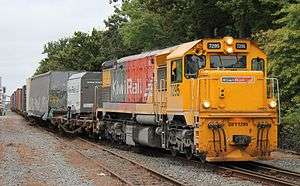 |
DFT | 7008 - 7348 | 30 | 1992 - 1997 | 2011–present | 1,800 kW (2,400 hp) | Rebuilt DF, with 18 later converted to DFBs ('T' for turbocharged). | ||
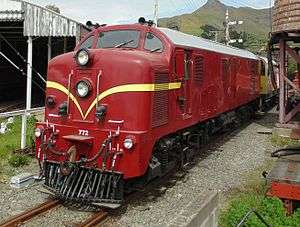 |
DG | DG | 2007 - 2468 | 750 - 791 | 42 | 1955 - 1956 | 1983 | 560 kW (750 hp) | 11 were rebuilt from the 1956 DH class. |
| DH (1956) | 766, 772, 777 - 783 | 11 | 1956 | 1968 | 560 kW (750 hp) | All were later reclassified as DGs | |||
| DI | DI | 1808 - 1843 | 1100 - 1104 | 5 | 1966 | 1988 - 1989 | 755 kW (1,012 hp) | ||
 |
DJ | DJ | 3009 - 3689 | 1200 - 1263 | 64 | 1968 - 1969 | 1986 - 1991 | 672 kW (901 hp) | Five in service with Dunedin Railways |
 |
DL | 9008 - 9688 | 63 | 2010–2018 | Still in use | 2,700 kW (3,600 hp) | |||
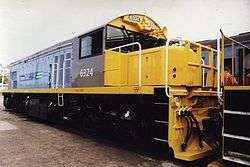 |
DQ | 6007 -6036, 6324 - 6416 | 15 | 1996 - 1998 | 1998 - 2013 | 1,120 kW (1,500 hp) | Rebuilt QR class; originally from Queensland Railways. | ||
 |
DX | DX | 5016 - 5520 | 2600 - 2648 | 48 | 1972 - 1975 | All Rebuilt as DXC & DXB | 2,050 kW (2,750 hp) | Two rebuilt as DXR. |
 |
DXB | 5016 - 5166 & 5448 | 14 | still in use | 2,050 kW (2,750 hp) | Upgraded DX class ('B' for Brightstar). | |||
 |
DXC | 5172 - 5520 5039 | 32 | still in use | 2,050 kW (2,750 hp) | DX class upgraded for the Midland Line coal trains ('C' for chute). | |||
| DXH | 0 | All rebuilt as DXB and DXC | 2,050 and 2,400 kW (2,750 and 3,220 hp) | Upgraded From DX | |||||
 |
DXR | 8007, 8022 | 2 | 1993, 2006 | still in use | 2,420 kW (3,250 hp) | Rebuilt From DX | ||
| QR | 2027 - 2102, 3032 | 25 | 1997 | 1999 | 1,120 kW (1,500 hp) | Originally from Queensland Railways; 15 rebuilt as the DQ class. | |||
Diesel shunting locomotives
| Image | Class | Numbers | Number in class | Year(s) introduced | Year(s) withdrawn | Power output | Notes | ||
|---|---|---|---|---|---|---|---|---|---|
| TMS (1980) | pre-1980 | TMS (1980) | pre-1980 | ||||||
| DAA | DAA | 11 - 63 | 1400 - 1404, 1406 | 5 | 1971 | 1989 | 1,060 kW (1,420 hp) | DA class refitted for low speed running for heavy shunting at Te Rapa. | |
 |
DAR | 517 | 1 | 1989 | 2008 | 1,060 kW (1,420 hp) | DA class modified for shunting at Tasman Pulp and Paper. | ||
| DE | DE | 1308 - 1458 | 501 - 515 | 15 | 1952 | 1984 - 1989 | 490 kW (660 hp) | ||
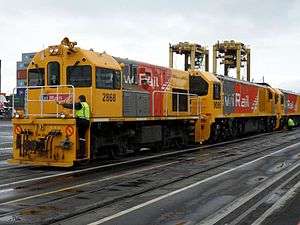 |
DH | DH | 2816 - 2868 | 900 - 905 | 6 | 1978 | Still in use | 672 kW (901 hp) | |
| DS | DS | 200-215 | 16 | 1949-1955 | 1978-1984 | ||||
| DSA | DSA | 1953-1967 | |||||||
| DSB | DSB | 1003-1290 | 300-327 | 28 | 1954-1967 | 1978-1988 | |||
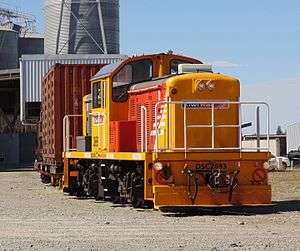 |
DSC | DSC | 2000 - 2759 | 400 - 469 | 70 | 1959 - 1967 | 1989–present | 315 kW (422 hp) | |
| DSG | 3005 - 3304 | 24 | 1981 - 1983 | still in use | 700 kW (940 hp) | Shunting locomotive. | |||
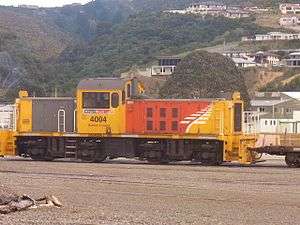 |
DSJ | 4004 - 4060 | 5 | 1984 - 1985 | still in use | 350 kW (470 hp) | |||
 |
TR | TR | 90 | 1924-1978 | Six distinct build models of various power, wheel set and body. | ||||
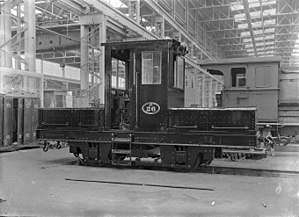 |
EB | 1809, 1815, 1821 | 3 | 1976-1980 | 23 kW (31 hp) | Used for internal workshop movements. Rebuilt in 1953 from the EB Battery-electric loco. | |||
Electric locomotives
| Image | Class | Numbers | Number in class | Year(s) introduced | Year(s) withdrawn | Voltage | Power output | Notes | ||
|---|---|---|---|---|---|---|---|---|---|---|
| TMS (1980) | pre-1980 | TMS (1980) | pre-1980 | |||||||
 |
EO | EA | 39 - 74 | 1 - 5 | 5 | 1968, 2008 | 1997, 2011 | 1500 V DC overhead | 960 kW (1,290 hp) | Originally classified EA, 1980 reclassified as EO. Used Otira-Arthurs Pass section, three returned to Wellington suburban service in 2008. Final withdrawal 2011. |
| EC | 7 - 12 | 6 | 1928 - 1929 | 1970 | 1500 V DC overhead | 885 kW (1,187 hp) | Used on Christchurch-Lyttelton line. | |||
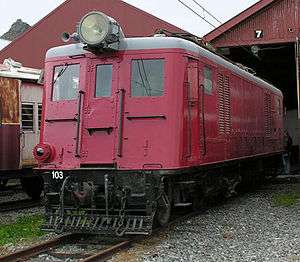 |
ED | ED | 15, 21 | 101 - 110 | 10 | 1938 | 1969 - 1981 | 1500 V DC overhead | 670 kW (900 hp) | Used on Wellington suburban network. |
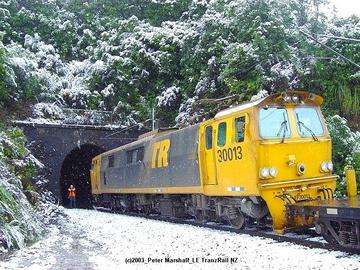 |
EF | 30007 - 30249 | 22 | 1986 - 1988 | 1991–present | 25 kV 50 Hz AC overhead | 3,000 kW (4,000 hp) | Originally Class 30, reclassified as EF class.
Used on the NIMT between Palmerston North and Hamilton. | ||
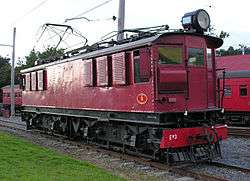 |
EO | 2 - 6 | 5 | 1923 | 1968 | 1500 V DC overhead | 510 kW (680 hp) | Used on Otira-Arthurs Pass section. Replaced by EA class (later reclassified as EO). | ||
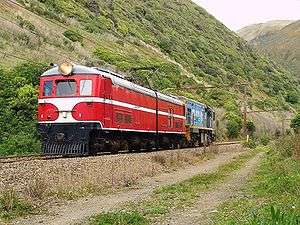 |
EW | EW | 107 - 171 | 1800 - 1806 | 7 | 1952 | 1988 | 1500 V DC overhead | 1,340 kW (1,800 hp) | Used on Wellington suburban network. |
Battery electric locomotives
| Image | Class | Numbers | Number in class | Year(s) introduced | Year(s) withdrawn | Power output | Notes | ||
|---|---|---|---|---|---|---|---|---|---|
| TMS (1980) | pre-1980 | TMS (1980) | pre-1980 | ||||||
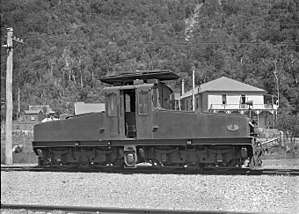 |
E | 1 | 1923 | 1930 | 131 kW (176 hp) | Used for maintenance in the Otira Tunnel. | |||
 |
EB | 25-29 | 5 | 1925-1929 | 1976-1980 | 23 kW (31 hp) | Used for internal workshop movements. Rebuilt in 1953 to diesel electric power. | ||
Electric multiple units
Wellington electric multiple units operate on 1500 V DC overhead. Auckland's electric multiple units run on 25 kV AC overhead.
| Image | Class | Number in class | Location | In service | Formation | Passenger capacity | Notes |
|---|---|---|---|---|---|---|---|
| DM/D | 49 | Wellington | 1938 - 2012 | D - DM (two-car) D - DM - D (three-car) |
132 (two-car) 204 (three-car) |
6 sets preserved in museum or private use. | |
 |
EM/ET | 44 | Wellington | 1982 - 2016 | EM - ET | 148 | One set preserved at Canterbury Railway Society. |
| FP/FT | 83 | Wellington | 2010–present | FP - FT | 147 | Named Matangi, after the Māori word for "wind". | |
 |
AM | 57 | Auckland | 2014–present | AMP - AMT - AMA | 230 |
Railcars
Livery: The first railcars were painted "carnation red" with a white or yellow stripe. The Silver Fern railcars appeared in stainless steel.
All railcars, unless otherwise stated, are designated RM class. Here, they are classified under their common names.
| Image | Class | Number in class | In service | Power type | Passenger capacity | Notes |
|---|---|---|---|---|---|---|
 |
88-seater | 35 | 1955 - 1978 | Diesel-mechanical | 88 | Alternatively known as Fiats, Eighty-Eights, or Twinset railcars. After withdrawal, 14 were converted to (locomotive-hauled) AC class articulated carriages known as "Grassgrubs" due to their green colour. |
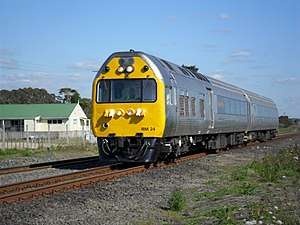 |
Silver Fern | 3 | 1972 – 2019 | Diesel-electric | 96 | Auckland - Wellington service, 1972-1991. Geyserland Express, Kaimai Express and Waikato Connection 1991-2001; used for excursions until 2019. Now withdrawn pending a future decision.[4] |
| Standard | 6 | 1938 - 1972 | Diesel-mechanical | 48 - 52 | Preserved examples exist at Silver Stream Railway (Wellington), Glenbrook Vintage Railway (Auckland) and Pahiatua Railcar Society (near Palmerston North). | |
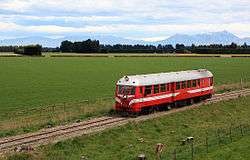 |
Vulcan | 9 | 1940 - 1978 | Diesel-mechanical | 48 - 50 | Examples are preserved at Ferrymead Railway, Christchurch (3 of) and Plains Railway, Ashburton (1 of). |
.jpg) |
Wairarapa | 7 | 1936 - 1956 | Diesel-mechanical | 25 - 49 | The remaining example is currently being restored by Pahiatua Railcar Society (near Palmerston North). |
Experimental railcars included the following:
| Image | Class | Number in class | In service | Power type | Passenger capacity | Notes |
|---|---|---|---|---|---|---|
 |
MacEwan-Pratt petrol railcar | 1 | 1912-1913 | Petrol | 12 | Never in revenue service. Not preserved. |
| Clayton steam railcar | 1 | 1926-1937 | Coal | Originally worked the Kurow branch, and later in Otago and Southland. Not preserved. | ||
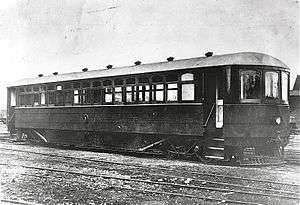 |
Edison battery-electric railcar | 1 | 1926-1934 | Electric (battery) | 60 seated, 70 total. | Used on Little River branch. Destroyed by fire. |
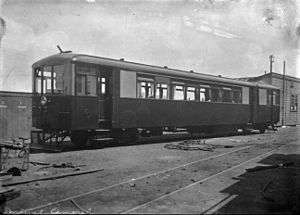 |
Sentinel-Cammell steam railcar | 1 | 1925-1931 | Coal | 48 | Used on Melling and then Thames branches. Not preserved. |
 |
Leyland experimental petrol railcar | 1 | 1925 | Petrol | Never entered revenue service. | |
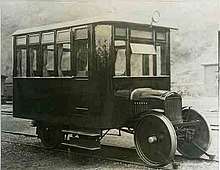 |
Model T Ford railcar | 2 | 1925-1931 | Petrol | 11 plus driver | Operated on Greytown branch and in Southland. A replica operates on the Pleasant Point Railway, near Timaru. |
%2C_1936_ATLIB_333448.png) |
Leyland diesel railbus | 2 | 1936-1942 | Diesel | 19 or 8 plus 1 ton of newspapers. | Served on Midland Line and the west coast. None preserved. |
Diesel multiple units
| Image | Class | Number in class | In service | Formation | Passenger capacity | Notes |
|---|---|---|---|---|---|---|
 |
ADK/ADB | 9 | 1993 - 2014 | ADK - ADB | 134 | Ex Transperth, used on Auckland suburban network. None preserved. |
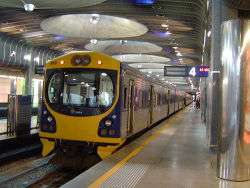 |
ADL/ADC | 10 | 1993–present | ADL - ADC | 128 | Ex Transperth, used on Auckland suburban network. |
Steam locomotives
Livery: New Zealand steam locomotives after the late 1920s were mainly completely black with red buffer beams at each end. Earlier steam locomotives were more varied in colour with a contrasting lining on the cab sides and side tanks, for example the green of the F class Peveril.
| Image | Class | Numbers | Number in class | Year(s) introduced | Year(s) withdrawn | Whyte notation | Notes |
|---|---|---|---|---|---|---|---|
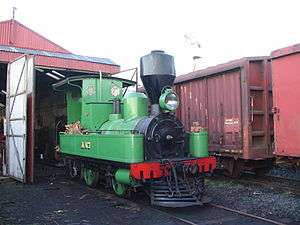 |
A of 1873 | 14 | 1873 | 1905 | 0-4-0T | ||
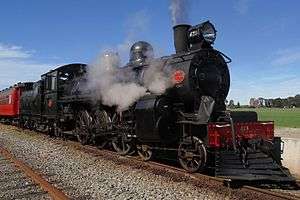 |
A of 1906 | 58 | 1906 | 1969 | 4-6-2 | Includes 30 locomotives reclassified from AD | |
| AA | 10 | 1914 | 1957 | 4-6-2 | |||
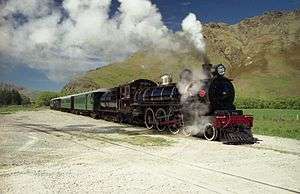 |
AB | 141 | 1915 | 1969 | 4-6-2 | New Zealand's most prolific steam locomotive; ten were rebuilt from WAB class. Preserved examples at Pleasant Point Railway (near Timaru), Steam Incorporated Paekakariki, Mainline Steam Heritage trust, Kingston Flyer (near Queenstown), Glenbrook/Motat (Auckland). | |
 |
AD | 30 | 1910 | 1916 | 4-6-2 | Reclassified A in 1916. | |
._ATLIB_257541.png) |
B of 1874 | 2 | 1874 | 1890 | 0-4-4-0T Double Fairlie |
||
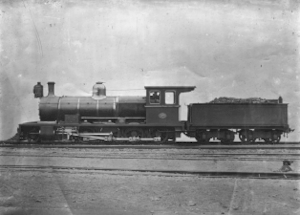 |
B of 1899 | 10 | 1899 | 1967 | 4-8-0 | Three rebuilt as WE class | |
 |
BA | 10 | 1911 | 1969 | 4-8-0 | ||
 |
BB | 30 | 1915 | 1968 | 4-8-0 | ||
._ATLIB_276308.png) |
BC | 1 | 1902 | 1927 | 2-8-2 | Originally from the Wellington and Manawatu Railway, which was nationalised in 1908. | |
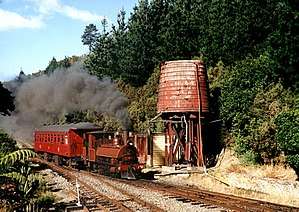 |
C of 1873 | 16 | 1873 | 1920 | 0-4-0ST original 0-4-2ST rebuild |
||
 |
C of 1930 | 24 | 1930 | 1968 | 2-6-2 | Built for heavy shunting at major yards, one preserved at Silverstream Railway (Wellington) and one at Ferrymead Railway (Christchurch). | |
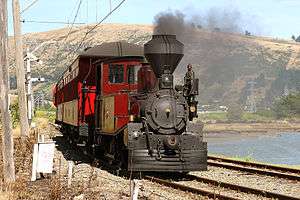 |
D of 1874 | 35 | 1874 | 1927 | 2-4-0T | A low powered locomotive, with many finding a second life as industrial locomotives or with the Public Works dept. Seven have survived, with operational examples at the Pleasant Point Railway (near Timaru) and Ferrymead (Christchurch). Static examples are at Silverstream Railway (Wellington) and Ocean Beach Railway (Dunedin). | |
_Josephine_Otago_Settlers_Museum.jpg) |
E of 1872 | 8 | 1872 | 1906 | 0-4-4-0T Double Fairlie |
A double fairlie, originally used only in the South Island, but one was used by the Public Works Dept. in the North Island. An static example of the E Class is preserved at the Otago Settlers Museum, Dunedin. | |
| E of 1906 | 1 | 1906 | 1917 | 2-6-6-0T Mallet |
|||
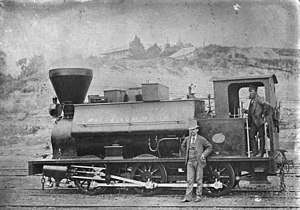 |
F | 88 | 1872 | 1964 | 0-6-0T | Ubiquitous and long-serving, nine examples of this class are preserved. Used in all roles, including mainline use and shunting. | |
 |
FA | 13 | 1892 | 1943 | 0-6-2T | ||
| FB | 13 | 1897 | 1943 | 0-6-2T | |||
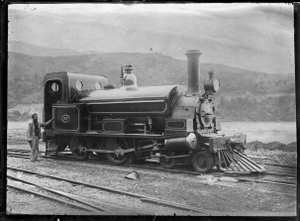 |
G of 1874 | 4 | 1874 | 1918 | 4-4-0ST | ||
| G of 1928 | 3 | 1928 | 1937 | 4-6-2+2-6-4 Garratt |
The only Garrett-type locomotive in NZ, they were not a success. All rebuilt as Pacifics, and became the G class of 1937. None preserved. | ||
| G of 1937 | 6 | 1937 | 1956 | 4-6-2 | Rebuilt from the unsuccessful Garrett G class of 1928. None preserved. | ||
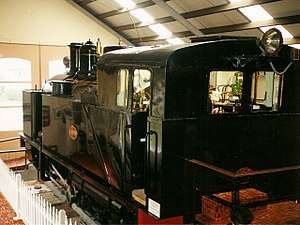 |
H | 199 - 204 | 6 | 1878 | 1955 | 0-4-2T Fell |
Built to work the Rimutaka Incline, H 199 is the only remaining Fell locomotive in the world and is preserved in the Fell Museum at Featherston, just north of Wellington. |
 |
J of 1874 | 32 | 1874 | 1935 | 2-6-0 | First locomotive class in NZ with a tender. | |
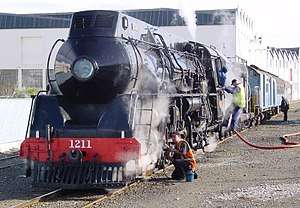 |
J of 1939 | 1200 - 1239 | 40 | 1939 | 1971 | 4-8-2 | A powerful, yet lighter locomotive than the K class. Coal burning and initially streamlined, 12 members of the class were rebuilt as JB class, being oil burners. Two operating examples remain, one at Mainline Steam and the other at Steam Incorporated. |
 |
JA | 1240 - 1290 | 51 | 1946 - 1956 | 1964 - 1971 | 4-8-2 | 1240 to 1274 were used exclusively in the South Island, and were coal burners. The second batch of 16 were oil burners, built by North British Locomotive Works. These were numbered 1275 to 1290 and were used in the North Island. The class includes JA 1274 - the last NZR steam locomotive built. Seven preserved, including at Mainline Steam, Plains railway (Ashburton), Steam Incorporated, Glenbrook Vintage Railway (Auckland) and a static exhibit in Dunedin. |
.jpg) |
JB | 12 | 4-8-2 | 12 locomotives were rebuilt from the 1939 J class as oil burners. | |||
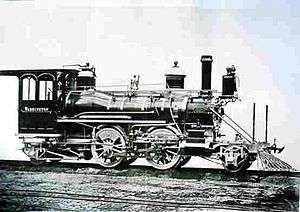 |
K of 1877 | 8 | 1877 | 1927 | 2-4-2 | Originally used solely in the South Island, including on the famous Kingston Flyer, they later received minor use in the North Island. | |
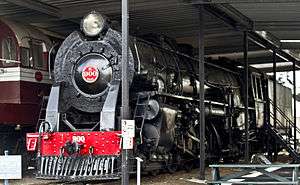 |
K of 1932 | 900 - 929 | 30 | 1932 | 1967 | 4-8-4 | |
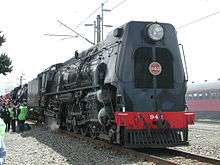 |
KA | 930 - 964 | 35 | 1939 - 1950 | 1964 - 1967 | 4-8-4 | A modified version of the K class, with roller bearings and ACFI feedwater heaters. |
 |
KB | 965 - 970 | 6 | 1939 | 1968 | 4-8-4 | A coal burning locomotive that was a KA class fitted with trailing-wheel boosters. Used solely in the South Island, almost exclusively on the midland line between Springfield and Arthur's Pass. A non-operating example is preserved at Mainline Steam, Christchurch. |
 |
L | 10 | 1877 | 1901 - 1939 | 2-4-0T 4-4-0T 4-4-2T |
||
 |
LA | 5 | 1887 - 1892 | 1920 - 1928 | 4-4-0T | Originally from the New Zealand Midland Railway, which was nationalised in 1900. | |
 |
M | 4 | 1875 | 1919 - 1928 | 0-6-0T 2-4-4T | ||
| N | 12 | 1885 | 1934 | 2-6-2 | Two originally from the Wellington and Manawatu Railway (nationalised 1908). | ||
| NA | 2 | 1894 | 1929 | 2-6-2 | Originally from Wellington and Manawatu Railway (nationalised 1908) | ||
| NC | 2 | 1902 | 1931 | 2-6-2 | Originally from Wellington & Manawatu Railway (nationalised 1908) | ||
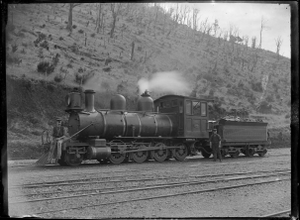 |
O | 6 | 1885 | 1922 | 2-8-0 | ||
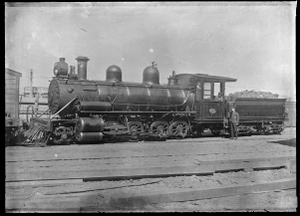 |
OA | 1 | 1894 | 1929 | 2-8-0 | Originally from Wellington & Manawatu Railway (nationalised 1908) | |
)._ATLIB_333419.png) |
OB | 2 | 1888 | 1931 | 2-8-0 | Originally from Wellington and Manawatu Railway (nationalised 1908) | |
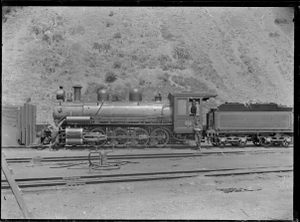 |
OC | 1 | 1896 | 1930 | 2-8-0 | Originally from Wellington and Manawatu Railway (nationalised 1908) | |
_ATLIB_308346.png) |
P of 1876 | 2 | 1876 | 1885 | 0-6-0ST | ||
_at_Frankton._ATLIB_293054.png) |
P of 1885 | 10 | 1885 | 1930 | 2-8-0 | ||
._ATLIB_307775.png) |
Q of 1878 | 2 | 1878 | 1898 | 2-4-4T | ||
_ATLIB_293603.png) |
Q of 1901 | 13 | 1901 | 1957 | 4-6-2 | The world's first 4-6-2 Pacific locomotive | |
 |
R | 18 | 1878 | 1936 | 0-6-4T Single Fairlie |
A Single Fairlie locomotive, designed for the tight curves and steep grades characteristic of rail in NZ at that time. Used in all roles from mainline passenger down to shunting and Public Works, private industrial and tramway use. A static example has been preserved at Reefton, on the west coast of the South Island. | |
 |
S | 7 | 1880 | 1927 | 0-6-4T Single Fairlie |
||
._ATLIB_333401.png) |
T | 6 | 1879 | 1928 | 2-8-0 | ||
 |
U | 9 | 1894 | 1959 | 4-6-0 | ||
.png) |
UA | 6 | 1899 | 1937 | 4-6-0 | ||
 |
UB | 22 | 1901 | 1957 | 4-6-0 | ||
 |
UC | 10 | 1901 | 1959 | 4-6-0 | ||
 |
UD | 2 | 1904 | 1931 | 4-6-0 | Originally from the Wellington & Manawatu Railway, which was nationalised in 1908. | |
 |
V | 13 | 1885 | 1937 | 2-6-2 | Three originally from the Wellington and Manawatu Railway (nationalised 1908) | |
._ATLIB_292904.png) |
W | 192, 238 | 2 | 1889 | 1959 | 2-6-2T | Tank locomotive, W 192, which was the first NZR locomotive built in New Zealand, is preserved and operational at Ferrymead Railway, Christchurch. |
 |
WA | 11 | 1892 | 1962 | 2-6-2T | Tank locomotive, 11 built new; four rebuilt from J class 1874. WA165 is believed to be the only locomotive of this class still existing. It is owned and operated by the Gisborne City Vintage Railway. | |
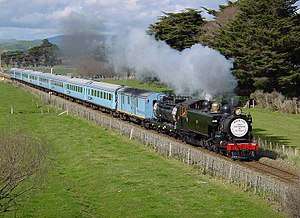 |
WAB | 30 | 1918 - 1927 | 1947 - 1969 | 4-6-4T | 14 rebuilt from WS class; 10 rebuilt as AB class | |
_ATLIB_292932.png) |
WB | 12 | 1898 | 1957 | 2-6-2T | ||
._ATLIB_292528.png) |
WD | 18 | 1901 | 1936 | 2-6-4T | ||
._ATLIB_292538_(cropped).png) |
WE | 3 | 1902 | 1969 | 4-6-4T | Rebuilt from B of 1899; equipped with Fell centre rail braking for use on the Rimutaka Incline and Rewanui Incline. | |
_ATLIB_257749.png) |
WF | 41 | 1904 | 1969 | 2-6-4T | ||
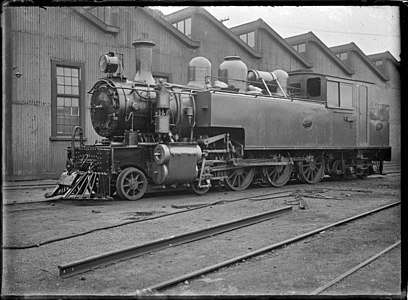 |
WG | 20 | 1910 | 1964 | 4-6-4T | 14 later rebuilt as WW class. | |
._ATLIB_292520.png) |
WH | 3 | 1884 | 1927 | 2-4-2T | Originally from Wellington and Manawatu Railway (nationalised 1908) | |
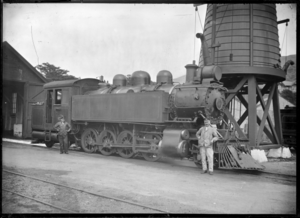 |
WJ | 1 | 1904 | 1928 | 2-8-4T | Originally from Wellington and Manawatu Railway (nationalised 1908) | |
 |
WS | 14 | 1917 | 1936 | 4-6-4T | All rebuilt as WAB class | |
 |
WW | 51 | 1913 | 1969 | 4-6-4T | 14 rebuilt from WG class | |
_steam_locomotive_588%2C_4-8-2_type._ATLIB_257736.png) |
X | 18 | 1909 | 1957 | 4-8-2 | The world's first 4-8-2 Mountain locomotive | |
| Y | 3 | 1923 | 1958 | 0-6-0T |
Steam locomotive notes:
- ^ Two other types of locomotives built in the 1870s were included in the A class. All three had a wheel arrangement of 0-4-0T, but were technically and aesthetically quite different. The other A types are often known as the Shanks A and the Mills A, after their respective builders.
- ^ A completely different type of locomotive was nominally classified as being the solitary member of the S class in 1877 (the main S class was not introduced until 1880), but it was typically known as Robina.
Industrial locomotives
A number of industrial locomotives were used by various operators connecting to the national rail network:
0-6-0 shunting locomotives
Similar to the NZR DS class:
- Drewry 2248/1947 was built for the Ohai Railway Board as their NO 1. The railway was operated by the State Mines, and in 1968, Drewry 2248 was dispatched with its sister, NO 2, to the State Mines railway between Stirling and Kaitangata in Otago. In 1974, both locomotives moved to Rotowaro in the North Island, where they both finished working. In 1986, the locomotive was withdrawn and sold to the Bush Tramway Club at Pukemiro Junction on the former Glen Afton Branch. On 21 October 2014, Drewry 2248 arrived at the Rimutaka Incline Railway Heritage Trusts Maymorn site after being purchased for restoration. Currently, Drewry 2248 is wearing a dark green livery in place of its original red.
- Drewry 2585/1957 shares a similar operating history to Drewry 2248. Built for the ORB as their NO 2, it ended up at Rotowaro in 1986, and was purchased by the Bush Tramway Club. However, in 2005 it was purchased by the Wallis family to start the 'Waikato Railway Heritage Trust', and moved to nearby Ngauruwahia. In April 2008 it moved again to Ngongotahā, and is now owned by the Rotorua-Ngongotaha Railway Trust. It is currently being overhauled, and is painted in State Mines yellow instead of its original red.
- Whakatane Board Mills 103 (maker's 2258/1947) was built for use over the WBM Matahina Tramway, bringing logs back from the Matahina area over the Tramway to the mill via the NZR Taneatua Branch. It was later joined by Whakatane Board Mills 104 (maker's 2489/1951); together, the two diesels displaced ex-NZR 0-6-2T tank locomotives FA 41 and FA 250. In later years, the two locomotives were limited to the short length of line between the mill and the NZR connection at Awakeri and were repainted from the original black with yellow trim into a white with orange band scheme.
In 1999, Tranz Rail purchased the line between Awakeri and the mill and took over shunting operations with DBR and DSC class diesel locomotives. The two Drewrys were then onsold to Forest Loaders, a subcontractor working for Tranz Rail in the Portland area, loading log wagons at Portland. Both locomotives were renumbered by Forest Loaders as FL 106 and FL 107 respectively. Both are now preserved by the Bay of Islands Vintage Railway.
Similar to the NZR DSA class:
- W. G. Bagnall - builder's number 3079, introduced 1954 and withdrawn 1989, formerly used by Tasman Forestry.
- W. G. Bagnall - builder's number 3132, introduced 1958 and withdrawn 1990, formerly used by Portland Cement as PC 10. Preserved, Whangarei Steam and Model Railway Club.
- W. G. Bagnall - builder's number 3144, introduced 1958 and withdrawn 1990, formerly used by Portland Cement as PC 11. Preserved, Waitara Railway Preservation Society.
Similar to the NZR DSB class:
- Road numbers ORBs 1 and 2
- Maker's Nos 1475 and 1476
Two 0-6-0 locomotives were built by Mitsubishi Heavy Industries for industrial service for the Ohai Railway Board in 1967.
- ORB 1 was withdrawn in 1989 due to heavier trains and was replaced by DJ3303. In 1990 the New Zealand Railways Corporation took over the Ohai Railway Board's section of the Wairio Branchline. It was then stored in Wairio until being sold to the Ohai Railway Board Heritage Trust for preservation.
- ORB 2 shares a similar operating history to ORB 1, but was withdrawn in 1990. Stored in Wairio until 1992 when it was purchased by Reid McNaught for Steam Incorporated. It was then sold to Richard Gibbard in the early 2000s and is still in service for shunting by Steam Inc.
- Road numbers 3079 (maker's number), WPC 10-11
- Maker's NO's 3079, 3132, 3144
A further three 0-6-0DM locomotives were built by W. G. Bagnall for industrial service in New Zealand. The first, Bagnall 3079 of 1954, was delivered to Tasman Pulp & Paper for use at their Kinleith paper plant in the Bay of Plenty. The other two, maker's nos. 3132 and 3144 of 1958, were delivered to Wilsons Portland Cement for use on their private quarry railway at Portland, just south of Whangarei. All three were exactly the same as the ten NZR locomotives which were built to the same pattern as Bagnall 3079. They were initially equipped with National M4AA6 diesel engines producing 240 hp (180 kW).
All three were later re-powered by A & G Price at their Thames workshops; Bagnall 3079 with a 315 hp (235 kW) Caterpillar D343T diesel engine and Twin Disc torque converter, while the two Portland locomotives, numbered WPC 10 (3132) and WPC 11 (3144) received 204 hp (152 kW) Gardner 8L3 diesel engines which were used in the DS and Drewry DSA class locomotives. Bagnall 3079 was also later fitted with extra ballast weight to increase its power output
- Bagnall 3079 was withdrawn in 1989 due to the increased shunting being beyond its capabilities. Replaced by chop-nosed DA 512, it was provisionally sold to the Bay of Islands Vintage Railway who planned to have it towed by rail to their Kawakawa depot. Unfortunately NZ Rail Ltd was concerned that the tyres needed reprofiling and wanted the locomotive to be road transported to Westfield depot in Auckland for this work to be carried before it could be moved by rail. Unable to meet the cost of transporting the locomotive and reprofiling the tyres, the BoIVR were unable to move the locomotive and it was later scrapped at Kinleith in 1990.
- WPC 10 and 11 were retired in 1990 when the Portland quarry railway closed. Both were sold to Kamo Engineering and were moved to their yard where the Gardner 8L3 engines were removed and fitted in a ship. After being stored in the yard for 15 years both were sold in 2005:
- WPC 10 was purchased by the Whangarei Steam and Model Railway Club and moved to their short line at the Whangarei Museum, Kamo in 2005. It has been cosmetically overhauled pending the arrival of a replacement Gardner 8L3 or similar low-revolution diesel engine. Its current livery is that of Wilsons Portland Cement Ltd, but with a darker shade of blue used in place of the original.
- WPC 11 moved to the Waitara Railway Preservation Society depot at Waitara Road (Brixton) in 2005. It stayed here for five years before moving to the Taranaki Flyer Trust's depot in the former Stratford goods shed. Since the trust folded this has returned to Waitara. Bagnall 3144 has not been restored and retains its original Portland Blue livery, albeit heavily faded and rust-streaked. A Gardner 8L3 engine has been acquired for this locomotive when restoration commences.
References
- KiwiRail 2011, p. 216.
- Parsons 2002, p. 15.
- McClare 1980, p. 30.
- "Railfan". 26 (1). Triple M Publications. Summer 2020. ISSN 1173-2229. Cite journal requires
|journal=(help)
Bibliography
- Barry, Colin; Brouwer, John; Dash, Colin; Dickenson, Peter; Shalders, Bruce (1988). Cavalcade 125. Ferrymead 125 Committee. Retrieved 22 March 2019.
- Heath, Eric; Stott, Bob (1993). Classic Railcars, Electric and Diesel Locomotives Of New Zealand. Grantham House. ISBN 1869340418.
- McClare, E J (1980). New Zealand Railway Diesels. Wellington, New Zealand: Southern Press. ISBN 9780907769286.
- Parsons, David (2002). New Zealand Railway Motive Power 2002. New Zealand Railway and Locomotive Society. p. 64. ISBN 978-0-908573-78-3.
- Palmer, A. N.; Stewart, W. W. (1965). Cavalcade of New Zealand Locomotives. Wellington: A H. & A W. Reed. ISBN 978-0-207-94500-7.
- Millar, Sean (2011). The NZR Steam Locomotive. Wellington: New Zealand Railway and Locomotive Society. ISBN 978-0-908573-89-9.
- KiwiRail Locomotive and Rolling Stock Register - 2011. Mosgiel, New Zealand: Triple M Productions. 2011. ISBN 978-0-9582072-2-5.